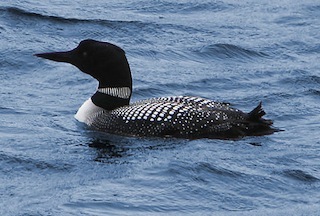 Great Northern Divers are winter visitors to the seas of the Lizard.
Great Northern Divers are winter visitors to the seas of the Lizard.
Photo: by P199
Scientific name: Gavia immer
Other common names: Common Loon (in North America)
Conservation status: IUCN Red List, Least Concern; UK Birds of Conservation Concern, Amber (because of the important overwintering population).
 The Great Northern Diver is a winter visitor to the shores of Europe, Africa and the United States, flying south from its breeding grounds in Iceland and Greenland, North America and the northernmost parts of Great Britain. Further south in the UK, a little over 2,500 birds arrive in the winter: northern and western Scotland and the Scottish islands host the largest numbers, but many come further south to Cornwall. Individuals can be seen offshore between late summer and spring, or inland on lakes and reservoirs, swimming elegantly through the water…but look out for their sudden dives into the water as they hunt for fish and crustaceans to eat.
The Great Northern Diver is a winter visitor to the shores of Europe, Africa and the United States, flying south from its breeding grounds in Iceland and Greenland, North America and the northernmost parts of Great Britain. Further south in the UK, a little over 2,500 birds arrive in the winter: northern and western Scotland and the Scottish islands host the largest numbers, but many come further south to Cornwall. Individuals can be seen offshore between late summer and spring, or inland on lakes and reservoirs, swimming elegantly through the water…but look out for their sudden dives into the water as they hunt for fish and crustaceans to eat.
All diver species are adapted to swim strongly underwater, hunting by sight and spearing fish with their bills: it is thought that the red eyes of the Great Northern Diver are an adaptation to help with vision underwater. Unlike most other birds, it also has solid bones: this reduces buoyancy, meaning it can dive deeply, at up to 60 m.
The photograph at the end of this article shows the far more distinctive summer breeding plumage, with the chequered patterning on the back and stripy neck patch. In winter, it can be confused, at a quick glance, with its cousins, the more numerous Black-throated Diver and Red-throated Diver. However, it is bigger than both, with a heavier, larger bill. Its wingspan is about 140 cm and it can be up to 1 m in length.
Did you know…?
…The name Loon given to the bird in North America is a reference to its haunting cry.
…The weight (from the size and solid bones) and shape (the legs are positioned relatively far back) of the Great Northern Diver are specialised for its powerful diving style: the trade-off is that the bird is not efficient at either taking off, landing on water or walking on land.
More information and references:
Gooders, J. and Harris, A., 1986. Field Guide to the Birds of Britain and Ireland. Kingfisher Books, London.
Published: February 2014 (updated February 2016)
Author: Amanda Scott
Photos: By P199 (Own work) [CC-BY-SA-2.5], via Wikimedia Commons
